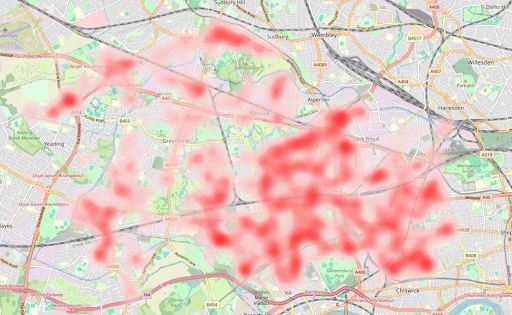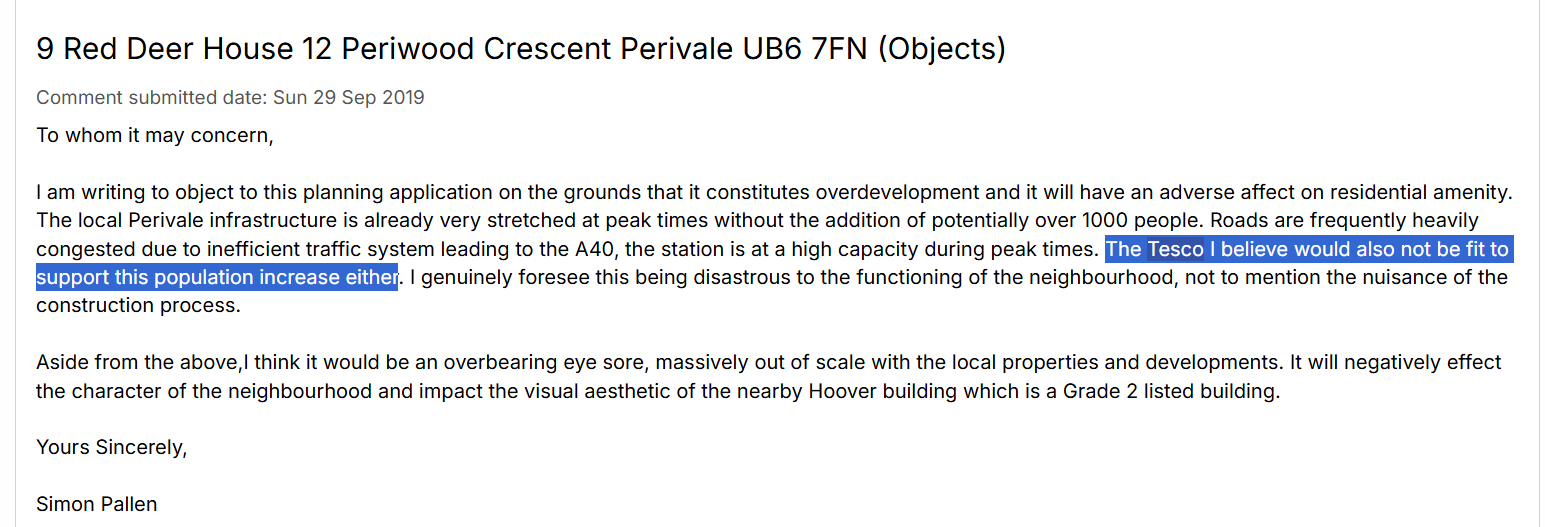Comments on planning applications are an often underutilised source of information in OSINT investigations. While planning requests themselves are recognised for their value, many investigators fail to dig deeper into the comments submitted to local authorities by members of the public, which provide an additional layer of insight. In this article, we will explore how these comments can be leveraged as a surprisingly rich dataset for various purposes, including asset tracing, understanding community sentiment, and identifying emerging patterns or entities of local importance.
Contact Data for Elusive Individuals
One of the most compelling uses of planning application comments is their ability to reveal contact details of individuals who may not appear in traditional records such as the Land Registry or electoral roll. These comments often include names, addresses, and, in some cases, email addresses of individuals who may be tangentially related to a property.
For instance, landlords or property owners who wish to remain anonymous might inadvertently reveal themselves through these comments. This makes planning application comments invaluable for asset tracing, especially when conventional sources fail to provide necessary leads.

Take, for example, the case of Alina Lubinska. She identifies herself in a planning comment but isn't registered at that address in any other records (take our word for it, or try it out yourself with Cradle).
Mapping NIMBYism
The aggregation of planning application comments into categories such as "Supports" and "Objects" offers a valuable lens for understanding public sentiment and resistance patterns—particularly when analysing the dynamics of NIMBYism (Not In My Backyard) across the UK. By examining these comments, investigators can identify regions that are more resistant or more welcoming to new developments, thus enabling the creation of detailed maps that reveal these variations.
For instance, our analysis of planning data in Ealing has shown that opposition is significantly higher in areas near busy roads and junctions. This pattern suggests a clear correlation between traffic concerns and objections to development proposals. Such insights are not only useful for understanding localised resistance but also for anticipating broader challenges that may arise in similar urban settings.
OSINT can help developers and planners navigate this resistance more effectively. In areas prone to objections, they can focus on addressing specific concerns—such as mitigating traffic impacts—to reduce opposition. Conversely, regions with stronger support for development may become strategic priorities, allowing for a more efficient allocation of resources.

NIMBYism presents a significant challenge to the UK's ability to meet housebuilding targets and advance onshore wind projects, often stalling or derailing critical developments. Policymakers and developers can use this public data to better understand local resistance, address concerns, and move forward with projects that balance community needs with national goals.
Investigating Neighbourhood Disputes
Planning application comments can also provide valuable insights into potential disputes between individuals and their neighbours. Negative comments or objections often highlight personal grievances related to the development, with some going as far as to mention past conflicts, personal dislikes, or concerns about individuals linked to the property. These interactions can shed light on disputes or tensions that might not be readily available through other public records.
This information can be particularly useful when investigating potential threats or ongoing disputes that may be of concern for personal security, as well as tensions that could be relevant in property purchase, divorce, or custody cases, such as disputes over property lines.
Entities of Local Importance
Public concerns raised in planning applications often highlight entities that consistently surface in contentious discussions, offering valuable insights for investigators. These entities can reveal significant community dynamics that may warrant further exploration.
In Ealing, for example, Tesco has repeatedly been mentioned in public objections to planning applications. Residents have voiced concerns that proposed housing developments could strain Tesco’s capacity to serve the community effectively. These recurring mentions make Tesco a central player in the community’s development conversations.
For investigators, this insight is significant. It can help identify key entities who are central to community dynamics, allowing for proactive engagement or further investigation into their roles. Understanding such patterns not only sheds light on specific points of tension but also provides a roadmap for addressing broader community concerns in the planning process.

Investigating Criminal Networks or Illicit Activities
Planning application comments can sometimes reveal suspicious patterns or activities that could be linked to criminal networks or illicit operations. Public objections or concerns related to unusual foot traffic, late-night activity, or specific individuals involved in the development may inadvertently highlight properties being used for illegal purposes such as drug manufacturing, human trafficking, unlicensed gambling, or other unlawful activities.
These comments can be invaluable for investigators working on criminal cases, offering leads that might not be visible in conventional records. For example, a comment raising concerns about frequent visitors or unusual deliveries to a property or overcrowding could point to a property used for illegal activities like drug and human trafficking, prompting further investigation into the property's history, ownership, and potential criminal links.
These remarks can serve as red flags for investigators, prompting them to dig deeper into the property's background and uncover any potential ties to illicit operations.
Insurance Fraud Investigations
Planning application comments can also be highly valuable in the context of insurance investigations, particularly when there are concerns over property damage or undeclared development of properties. Objections or public concerns related to the construction, alteration, or renovation of properties often raise issues that may be directly relevant to an ongoing insurance claim investigation or a breach of an existing policy.
Relevant comments can help investigators assess whether a claim is valid or if a policyholder failed to disclose relevant changes to the property. Investigators may also uncover fraudulent activity by identifying discrepancies between public concerns raised in planning comments and the reported status of a property.
By analysing these comments, insurance investigators can gain a fuller understanding of the risks associated with a property and better assess the validity of claims.
Taking the Next Steps with Comment in Planning Requests
As this article shows, comments in planning applications are a valuable resource for investigations, offering insights that go beyond the core application details. Most importantly, the contact details found within these applications are crucial for asset tracing and other investigative efforts, especially when traditional sources like the Land Registry or electoral data fall short. Additionally, the aggregation of public datasets such as planning applications offers a broader perspective, revealing trends and patterns—whether it’s mapping public sentiment, identifying problematic entities, or understanding community dynamics. Together, these capabilities highlight the untapped potential of planning applications as a critical tool in OSINT and investigative work.
Explore how Public Insights can support your OSINT efforts with a trial at cradle.publicinsights.uk.